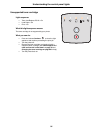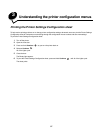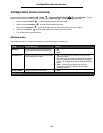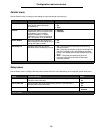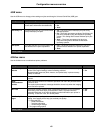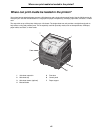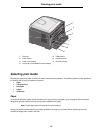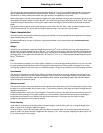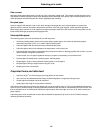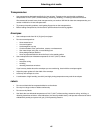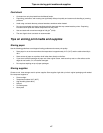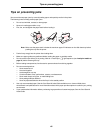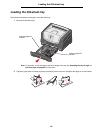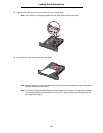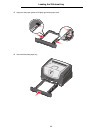
44
Selecting print media
The laser printing process heats paper to high temperatures of 210°C (410°F) for non-MICR applications. Use only paper
able to withstand these temperatures without discoloring, bleeding, or releasing hazardous emissions. Check with the
manufacturer or vendor to determine whether the paper chosen is acceptable for laser printers.
When loading paper, note the recommended print side on the paper package, and load paper accordingly. The printer can
automatically feed paper weights from 60 to 90 g/m
2
(16 to 24 lb bond) grain long. Paper lighter than 60 g/m
2
(16 lb) might
not be stiff enough to feed properly, causing jams. Paper heavier than 90 g/m
2
(24 lb) should be fed through the manual
feeder.
The duplex unit only supports certain sizes and types of print media. Only A4-, letter-, legal- and folio-size paper can be
used for duplex printing. The printer does not support duplex printing on any other type of print media.
Paper characteristics
The following paper characteristics affect print quality and reliability. It is recommended that these guidelines are followed
when evaluating new paper stock.
For detailed information, see the Card Stock & Label Guide available on the Lexmark Web site at www.lexmark.com/
publications.
Weight
The printer can automatically feed paper weights from 60 to 90 g/m
2
(16 to 24 lb bond) grain long in the integrated and
optional trays and paper weights from 60 to 163 g/m
2
(16 to 43 lb bond) grain long in the manual feeder. Paper lighter than
60 g/m
2
(16 lb) might not be stiff enough to feed properly, causing jams. For best performance, use 75 g/m
2
(20 lb bond)
grain long paper. To use paper narrower than 182 x 257 mm (7.2 x 10.1 in.), it is recommended that the weight be equal to
90 g/m
2
(24 lb bond).
Curl
Curl is the tendency of media to curve at its edges. Excessive curl can cause paper feeding problems. Curl can occur after
the paper passes through the printer, where it is exposed to high temperatures. Storing paper unwrapped in hot, humid,
cold, and dry conditions, even in the trays, can contribute to paper curling prior to printing and can cause feeding problems.
Smoothness
The degree of smoothness of paper directly affects print quality. If the paper is too rough, the toner does not fuse to the
paper properly, resulting in poor print quality. If the paper is too smooth, it can cause paper feeding or print quality issues.
Smoothness needs to be between 100 and 300 Sheffield points; however, smoothness between 150 and 250 Sheffield
points produces the best print quality.
Moisture content
The amount of moisture in the paper affects both print quality and the ability of the printer to feed the paper properly. Leave
the paper in its original wrapper until it is time to use it. This limits the exposure of the paper to moisture changes that can
degrade its performance.
Condition paper while it is still in the original wrapper. To condition it, store it in the same environment as the printer for 24
to 48 hours before printing to let the paper stabilize in the new conditions. Extend the time several days if the storage or
transportation environment is very different from the printer environment. Thick paper may also require a longer
conditioning period because of the mass of material.
Grain direction
Grain refers to the alignment of the paper fibers in a sheet of paper. Grain is either grain long, running the length of the
paper, or grain short, running the width of the paper.
For 60 to 90 g/m
2
(16 to 24 lb bond) paper, grain long fibers are recommended. It is not recommended that short grain
paper be used in any paper size with a weight less than 64 g/m
2
(17 lb), in A5-size paper weighting less than 70 g/m
2
(18
lb), or in A6-size paper of any weight.



